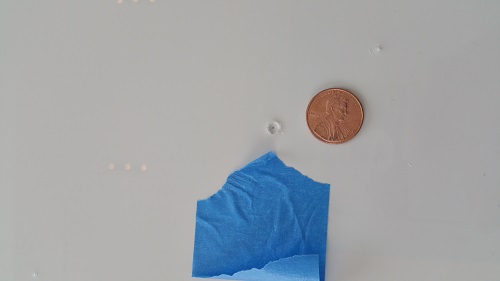Your new epoxy floor installation is complete, and as it has begun to set you notice… bubbles?
Small, perfectly round circles have popped up on the surface of your freshly applied epoxy coat. Fear not, as this issue is actually a very common byproduct of an effect called “outgassing.”
And while this surface anomaly may take away from your floor’s aesthetics at first, it does not affect the integrity of the coating itself.

A pinhole with size comparison.
What is ‘Outgassing’?
Outgassing occurs when trapped air or gassesgases inside the concrete are released. This condition is temporary and typically happens during installation, unlike the more serious issue of moisture vapour transmission (MVT), as we’ve covered in a previous blog series.
Outgassing produces two distinctive faults: small blisters, referred to as “pinholes,” which leave a small, round crater in the coating after popping or the release of gas.
The other is bubbles that emerge out of the coating.

Pinholes on the surface of an epoxy floor.
What causes this to happen?
As an epoxy floor sets and outgassing occurs, bubbles rise to the surface and can trap liquids and dirt.
Bubbling can also happen if the concrete itself has air trapped inside. When pouring an epoxy floor, the air might then escape from the concrete and cause bubbles on the surface. The outgassing can occur from changes in conditions in the space, as well.

But what can be done about the bubbles and pinholes in the epoxy?
There are several methods professionals employ in removing bubbles from epoxy floors. They include:
- Roll it out. Spike rollers can remove bubbles quickly in the epoxy floor.
- Reprime time. If bubbles rise after the installation due to outgassing of the concrete , then it may require a reprime of the affected area. This ensures the integrity of the floor when applying future coats.
- Sand it down. If bubbles are present following several additional coats, an installer may choose to sand down the affected area, followed by patching the area prior to applying a topcoat.
- Give it some heat. For a few scattered bubbles, a simple heat gun can easily break up bubbles.
It’s important to remember that while epoxy bubbles and craters may be an unattractive sight, they do not affect the bond strength of the coating. And while installers have a few tricks up their sleeves to tame outgassing bubbles, always seek out professionals who take the time to conduct proper preparation and avoid issues from the beginning of an installation.
For a century and counting, Stonhard has delivered proven, single-source service, covering both products and installation. Do you have questions about our products? Contact us and your local territory manager or architectural engineering & design representative will be happy to answer!